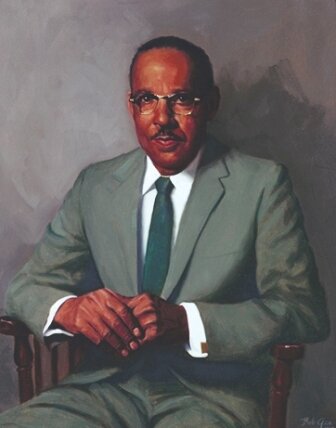Some of you might consider one of these following facts about Vivien Thomas really useful and interesting. As you know, Vivien Thomas was an African-American surgical-technician who developed the procedure used to treat blue baby syndrome in the 1940s. He was an assistant to surgeon Alfred Blalock in Blalock’s experimental animal laboratory at Vanderbilt University in Nashville, Tennessee, and later at the Johns Hopkins University in Baltimore, Maryland. Without any education past high school, Thomas rose above poverty and racism to become a cardiac surgery pioneer. To get to know more information about who he was, here are some facts about Vivien Thomas you might like to know.
Facts about Vivien Thomas 1: Working with Blalock
Thomas and Alfred Blalock did groundbreaking research into the causes of hemorrhagic and traumatic shock. This work later evolved into research on Crush syndrome and saved the lives of thousands of soldiers on the battlefields of Second World War. In hundreds of flawlessly executed experiments, the two disproved traditional theories which held that shock was caused by toxins in the blood.
Facts about Vivien Thomas 2: Decisive Surgery
On November 29, 1944, the procedure was first tried on an eighteen-month-old infant named Eileen Saxon. The blue baby syndrome had made her lips and fingers turn blue, with the rest of her skin having a very faint blue tinge. She could only take a few steps before beginning to breathe heavily.
Facts about Vivien Thomas 3: An Incomplete-successful Surgery
The surgery was not completely successful, though it did prolong the infant’s life for several more months. Blalock and his team operated again on an 11-year-old girl, this time with complete success, and the patient was able to leave the hospital three weeks after the surgery. Next, they operated upon a six-year-old boy, who dramatically regained his color at the end of the surgery.
Facts about Vivien Thomas 4: Relations with Blalock
Blalock’s approach to the issue of Thomas’s race was complicated and contradictory throughout their 34-year partnership. On the one hand, he defended his choice of Thomas to his superiors at Vanderbilt and to Hopkins colleagues, and he insisted that Thomas accompany him in the operating room during the first series of tetralogy operations. On the other hand, there were limits to his tolerance, especially when it came to issues of pay, academic acknowledgment, and his social interaction outside of work.
Facts about Vivien Thomas 5: Working at Johns Hopkins
By 1940, the work Blalock had done with Thomas placed him at the forefront of American surgery, and when he was offered the position of Chief of Surgery at his alma mater Johns Hopkins in 1941,he requested that Thomas accompany him.Thomas arrived in Baltimore with his family in June of that year,confronting a severe housing shortage and a level of racism worse than they had endured in Nashville.
Facts about Vivien Thomas 6: Blue Baby Syndrome
In 1943, while pursuing his shock research, Blalock was approached by renowned pediatric cardiologist Dr. Helen Taussig, who was seeking a surgical solution to a complex and fatal four-part heart anomaly called Tetralogy of Fallot also known as Blue Baby Syndrome. In infants born with this defect, blood is shunted past the lungs, thus creating oxygen deprivation and a blue pallor.
Facts about Vivien Thomas 7: Automatic Implantable Defibrillator
After Blalock’s death from cancer in 1964 at the age of 65, Thomas stayed at Hopkins for 15 more years. In his role as director of Surgical Research Laboratories, he mentored a number of African-American lab technicians as well as Hopkins’ first black cardiac resident, Dr. Levi Watkins, Jr., whom Thomas assisted with his groundbreaking work in the use of the Automatic Implantable Defibrillator.
Facts about Vivien Thomas 8: Johns Hopkins School of Medicine
In July 2005, Johns Hopkins School of Medicine began the practice of splitting incoming first year students into four colleges, each named for famous Hopkins faculty members that had major impacts on the history of medicine. Thomas was chosen as one of the four, along with Helen Taussig, Florence Sabin and Daniel Nathans.
Facts about Vivien Thomas 9: Death and Book
Following his retirement in 1979, Thomas began work on an autobiography. He died on November 26, 1985, of pancreatic cancer, at age 75, and the book was published just days later. Having learned about Thomas on the day of his death, Washingtonian writer Katie McCabe brought his story to public attention for the first time in a 1989 article entitled “Like Something the Lord Made”.
Facts about Vivien Thomas 10: Legacy
Thomas’s legacy as an educator and scientist continued with the institution of the Vivien Thomas Young Investigator Awards, given by the Council on Cardiovascular Surgery and Anesthesiology beginning in 1996. In 1993, the Congressional Black Caucus Foundation instituted the Vivien Thomas Scholarship for Medical Science and Research sponsored by GlaxoSmith Kline.
Hope you found those Vivien Thomas facts really useful and interesting for your additional reading.










 www.PortlandPayday.Loans
www.PortlandPayday.Loans